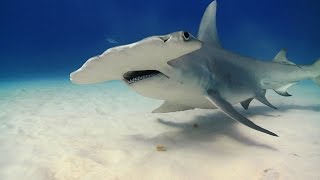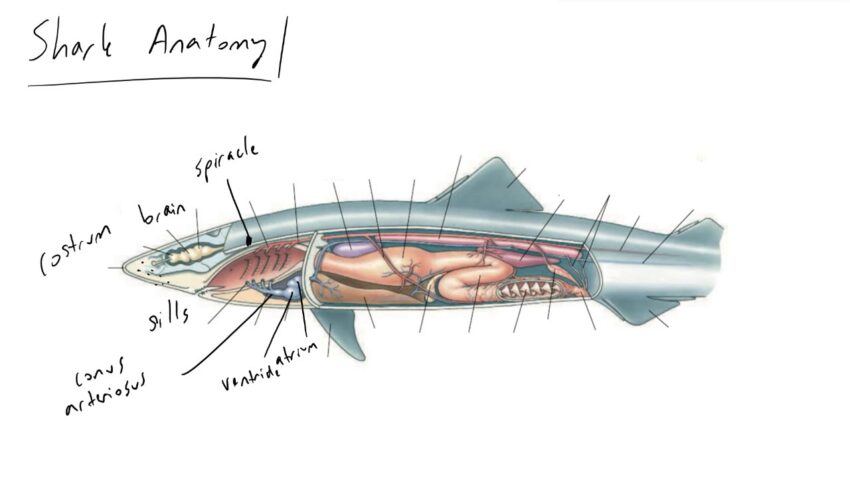Sharks have fascinated people for hundreds of years. While Tiger and Hammerhead sharks gained their popularity from their interesting appearance, the popularity of the Great White shark only serves to incite fear in its curious fans. The movie Jaws prominently featured a boat of people that were attacked by a Great White shark.
The three most recognizable sharks in the world are the Great White, Hammerhead and Tiger shark.
Great White Shark Facts
Table of Contents
Great White sharks live in coastal waters and are considered to be endangered. Once born, the shark leaves its mother and immediately begins fending for itself. Many young sharks will not make it past their first year of life due to predators that are temporarily larger than they are. The shark’s body has a torpedo shape, with five gill slits, a dorsal fin, and two side fins. The shark has about 3,000 teeth. Great White sharks swallow chunks of their prey whole.

The size of the Great White has been a subject of debate among many. While the shark averages 15 feet in size, the Guinness Book of World Records records that a 41-foot Great White was caught in the Azores Islands.
This shark is known to eat fish, sea lions, seals, sea turtles, other sharks, and small whales. It has a media reputation for feeding off humans. While Great Whites have been known to bite people, these instances are usually non-fatal and are considered by some as the shark merely sampling its prey.
Tiger Shark Facts
The Tiger Shark is named for its tiger-like strips that cascade down its body. This particular shark can live up to 50 years, span 14 feet in size and weigh almost 1,500 pounds. The Tiger shark is commonly found in tropic and sub-tropic water conditions and is known to eat almost anything, including fish, seals, humans, and garbage. Tiger sharks are hunted for their flesh, liver, and body. These sharks can give birth to almost 60 sharks at once.
Hammerhead Shark Facts
The Hammerhead is a carnivorous shark that can span 20 feet long, weigh up to 1,000 pounds and live up to 30 years. This species is found in tropical and subtropical areas around the world. They are known to eat fish, stingrays and other sharks. Unlike most other sharks, Hammerheads will travel in large schools of sharks, sometimes in schools of up to 500, during the day. When night comes, the sharks disperse.

The Hammerhead has a distinctly hammer-shaped head, and its eyes extend far to the left and right of its face. The shark is suitably named after its appearance. The female hammerhead shark will vigorously shake her head back and forth in the middle of the school, which is thought to be a part of the mating ritual to incite other females to flee the outskirts of the school. Male Hammerheads take to biting the female until she submits to mating with him. The Hammerhead female gives birth to 20-40 sharks at a time.
Do sharks lay eggs?
You bet but some of them give live birth too. How is this possible? Read the article below to find out about different types of sharks.
Our knowledge about shark reproduction is very limited, even amid today’s science and technology. However, scientists are studying them all the time and are finding out more about these fierce ‘eating machines’ that swim in our oceans.
Some sharks (about 70% according to the Florida Museum of Natural History) share an almost human reproduction system, if from outward observations only. Researchers have found that most shark babies are delivered as live young, although they are ‘hatched’ from eggs inside the mother shark’s womb.
Shark Anatomy
To explain: The male shark’s sensory organs tell him to approach the female and he grasps her with his teeth to hold on to her while copulation takes place. He inserts one of his claspers into the female’s body, injecting live sperm into her upper fallopian tubes and then he lets go. The sperm fertilizes the tiny oocytes, which become baby shark embryos, and they move to the lower fallopian tubes that will form as a womb for them.
In about 70% of all sharks (viviparous sharks), the fertilized eggs stay inside the female’s body and are not laid. A special gland called the nidamental (or shell) gland encases the fertilized ovum in a very thin membrane as a shell. The baby sharks’ embryos are then protected inside the mother’s body for 6 to 22 months (depending on what kind of shark), where the pups develop and thrive until birth.
In the other 30% of sharks (oviparous sharks), that nidamental gland makes a hard, protective shell around the embryo, and the female shark lays her fertilized eggs on the ocean bottom in a place she feels will be safe from predators. This kind of female shark is now finished with those babies and will likely never revisit the site or see the pups.
When gestation or egg-developing time is over, the energetic shark pups move around until they break open the shell (or membrane) and come out of the shell (or out of the mother’s body). The viviparous sharks will expel the pups, having the appearance of giving live birth to babies that are 45-60cm long.
Sharks Lay Eggs in the Ocean
Shark eggs laid on the ocean bottom measure roughly 10-25cm in length and contain a large yolk to nourish the developing shark until they’re ready to hatch; also 6-22 months. They can be round or oval, depending on the species, and one shark lays corkscrew shaped eggs, enabling the female to lodge it between rocks for safety from being washed away.
The shark’s eggs hatch when they’re ready, and those pups never see the mother. Mother sharks do not take care of their young beyond birth or hatching, and all shark pups are instantly ready to swim away and begin hunting for food.
There is one viviparous shark, the Sandtiger shark, and the first two embryos develop faster than the others. When the first two pups are developed enough to begin eating, they eat all the other pups in the womb (and possibly each other), ensuring their own survival.
Swell sharks, Dogfish, Angel sharks, and Skates and Rays lay eggs that have a curious shell that people have called a Mermaid’s Purse. It’s a hard casing around a shark egg that has hooks on either side of it, and it looks something like a tiny purse. Sometimes after storms or rough seas these small ‘purses’ will wash on shore and people find them a curious item.
Anatomy of the Shark
The shark has been around in its present form for millions of years. It is a masterpiece of evolution – perfectly adapted to its environment.
It is fairly common knowledge that the sharks has been swimming the world’s oceans for millions of years in pretty much the same form as we see today. Aeons ago this magnificent creature evolved to a point where it was perfectly suited to its environment. Then it seemed to stop evolving, and has remained a wonderfully efficient eating machine, without natural predators or rivals.
The Teeth and Jaw of Sharks
A shark’s teeth are its primary weapon. They are used for tearing off chunks of tissue from prey- creatures. Row upon row of serrated, triangular daggers line its jaw. The first row is erect and ever ready to slice tissue. Should a tooth be broken whilst grabbing a meal, the tooth behind it will move into place to fill the space vacated. Thus the shark’s arsenal is always on full alert.
In addition to the fearsome teeth, the upper jaw is not rigidly fixed to the skull. This means that the shark can swing the upper jaw upwards and forwards to get a bigger bite.
Shark Hunting Senses
All the prey-grabbing equipment in the world is no good unless prey is locatable. Here the shark excels.
Even in the clearest water, visibility is never more than a few hundred feet. More than eyes are needed to find food at all but the shortest ranges. Consequently a shark’s eyes are not a shark’s primary hunting sense. These are only used in the last stages of an attack. During the attack proper they are covered over by a special membrane to protect them from damage.
Long distance prey location is performed with a combination of smell and hearing.
A huge amount of the shark’s brain is dedicated to the sense of smell. Concentrations of blood as low as a few parts per million can be scented drifting on the ocean currents and get the shark moving in the correct direction.
Sound travels much more efficiently under water than in air. The shark’s “ear” is a line of receptors along each side of the body and is extremely acute at picking up vibrations. As the shark begins to near its potential prey, sounds given off by its movement will inform the shark of size, health and precise location.
Once the shark gets even closer, a row of sensors under the snout come into play. These are believed to pick up electric signals from the intended victim’s muscle movements.
It is interesting to note that a smoothly swimming human gives off a very similar electrical “pulse-pattern” and “sound-picture” to that of a wounded seal – a Great White Shark’s favorite meal.
The Liver
Somewhere along its evolutionary path the shark neglected to develop a swim bladder. This is an organ present in all bony fish which controls buoyancy and, consequently, depth. The shark did not need to develop the swim bladder, as it already had a perfectly good system in place.
There is a common misconception that if a shark stops swimming it will sink to the bottom of the sea.
Most sharks do not seem to need to move very much at all in order to stay buoyant. Their buoyancy, in most part, comes from their liver which is a massive organ, and can account for up to a quarter of the animal’s body-weight. This organ is very rich in oil which is lighter than water and aids in buoyancy.
Thus a shark can regulate its buoyancy by eating. The more it eats, the more oil the liver produces and, the lighter the shark.
The Digestive System of a Shark
A shark’s digestive system comprises of two sections – the stomach and the intestine. The intestine is where most digestion takes place.

The stomach, however, seems to be a kind of holding tank, where little or no digestion takes place.
Urban legends abound of entire horse carcasses – and the like – being found, relatively whole, in sharks’ stomachs. The logistics of such large objects finding their way down a shark’s throat would tend to make these stories suspect. But there is plenty of evidence that sharks swallow some pretty strange stuff. There is also evidence that some of the strange objects that have been swallowed have remained in the stomach for extended periods, while more recent snacks have been digested. This would suggest a kind of “selective digestion”.
Why would a shark swallow something if not for nourishment?
Perhaps an extremely well-fed shark with an excess of liver oil would become so buoyant that diving would be difficult. Is it possible that they swallow things to add a bit of ballast?
Given that even in the largest sharks, the brain is never much above three inches in length, it would seem that thought is not a driving force in a shark’s existence. It is equipped with such sophisticated sensors, flesh-ripping tools and weight- control mechanisms that thought is not necessary.
Instinct, and a wonderful adaptation, has kept them alive and flourishing since before the dinosaurs ruled the planet.
A List of Endangered Sharks
Many species of shark are endangered or vulnerable to extinction. Find out which species are endangered sharks and how people are threatening these animals.
Although sharks are fierce, streamlined predators they are no match for humans. Despite being portrayed as vicious man-eaters in the media, sharks are actually under enormous threat from human hunting. Over the past few decades many shark populations have dramatically dropped and shark conservation efforts have been slow to catch up.
How Many Sharks are Endangered?
The International Union for the Conservation of Nature (IUCN) recently studied open ocean sharks and rays, and explained their findings in the June 2009 press release “Third of open ocean sharks threatened with extinction”. There are 64 known species of pelagic sharks and rays, 32% of which are categorized as either: vulnerable, endangered, or critically endangered.
However, this particular IUCN list doesn’t include non-pelagic species such as endangered sharks living in mangrove forests, in rivers, or that are primarily benthic. Further, deep sea sharks are very difficult to study and little is known about their numbers. Thus it is difficult to create a full list of endangered shark species. However, enough is known now to illustrate the gravity of the situation and the need to take action.
Well-known Endangered Sharks
The IUCN’s report The Conservation Status of Pelagic Sharks and Rays includes the following well-known sharks among the 64 studied:Scalloped Hammerhead (Sphyrna lewini) – Status: Endangered
- Great Hammerhead (Sphyrna mokarran) – Status: Endangered
- Great White Shark (Carcharodon carcharias) – Status: Vulnerable
- Whale Shark (Rhincodon typus) – Status: Vulnerable
- Longfin Mako (Isurus paucus) – Status: Vulnerable
- Bull Shark (Carcharhinus leucas) – Status: Near Threatened
Further sharks however are listed on the IUCN’s website in their Red List of Threatened Species database. These endangered sharks include the following sharks and many more:
- Sharptooth Lemon Shark (Negaprion acutidens) – Status: Vulnerable
- Tawny Nurse Shark (Nebrius ferrugineus) – Status: Vulnerable
- Striped Dogfish (Mustelus fasciatus) – Status: Critically Endangered
- Whitetip Shark (Carcharhinus longimanusi) – Status: Globally Vulnerable, Critically Endangered in the Northwest and Western Central Atlantic
Shark Conservation and What Can Be Done
Estimates say that over 100 million sharks are killed annually, according to the WWF’s webpage “Pelagic sharks”. Many of these fish are caught unintentionally as bycatch in nets meant for tuna and swordfish. However, many endangered sharks are killed solely for their fins which ultimately become the Asian delicacy shark fin soup. The WWF says around 10 million blue sharks are killed annually just for their fins. Sport fishing and habitat loss have also impacted shark populations which are slow to rebound due to slow reproduction rates.
Fortunately, many shark conservation organizations do exist in order to study sharks, educate the public, and help save these magnificent animals. Anyone can help save the sharks however by eating only sustainable caught seafood, telling their friends to adopt a shark, and encouraging people to avoid shark fin soup.
Sources:
- NewsBBC.co.uk, “Do Sharks Lay Eggs?”
- Shark.ch,”Shark Reproduction”
- Florida Museum of Natural History, “Most Commonly Asked Questions”
- KidZone.ws, “Shark Facts”
